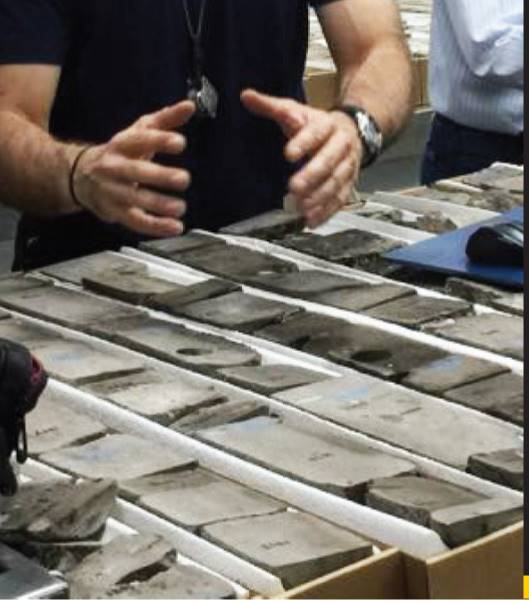A comprehensive and flexible course is designed for attendees to build theoretical knowledge and practical skills in core-based carbonate or clastic reservoir description

The course delivers an introductory, intermediate and advanced level of understanding of core-based reservoir descriptions.
3-day course – introductory level:ideal for petrophysicists, geophysicists and petroleum engineers who utilise core description data
5-day course – intermediate level:targeted for petroleum geologists, petrophysicists and engineers who would like to become more familiar with sedimentological core descriptions and interpretations
15-day course – advanced level:designed for geoscientists who will perform core descriptions and would like to gain a better understanding of well log constrains, reservoir architecture and quality.
This comprehensive and flexible course is designed for attendees to build theoretical knowledge and practical skills in core-based carbonate or clastic reservoir description (introductory and intermediate levels) and its integration with wireline log data in order to facilitate well log interpretation and to unravel the architectures of the selected reservoir(s) within a sequence stratigraphic framework (advanced level).
Attendees of the advanced course will also gain an overview of the diagenetic history of the selected reservoir(s), looking at both primary and secondary influences on reservoir quality. Attendees will have the opportunity to identify key diagenetic phases in core/thin-section and to discuss how they may affect reservoir quality distribution and prediction.
This course links to other carbonate/clastic courses that Badley Ashton offer and can be tailored to a study-specific reservoir and field. It can also be readily integrated with a commissioned project.
The course is designed to be run alongside the core for a maximum duration of three weeks, but can be tailored on demand. It is organised into three modules of multiple sessions, which are:
Module 1: Introduction to sedimentological core description and interpretation (introductory and intermediate course)
A. Sedimentological characteristics, surfaces and allochems.Purpose: to recognise and understand the depositional implications of lithofacies, surface types and allochems; supplemented by individual reading. 0.5 day.
B. Introduction to facies analyses and carbonate/clastic depositional environments.Purpose: to become familiar with key characteristics of the main carbonate/clastic deposits and their meaning in terms of depositional environments. 0.5 day.
C. Core familiarisation.Purpose: to become familiar with core description methodologies and to be aware of core curation issues. In addition key cements and different pore types that reflect variations in diagenetic evolution will be reviewed in core. 1 day.
D. Core description exercise: 50ft of core (per 2 trainees).Purpose: to describe a full core with a variety of sedimentological and diagenetic characteristics. 1 day for introductory course and up to 3 days for intermediate course to deliver a more in-depth understanding of the variety and challenges of core descriptions.
Module 2: Sedimentological characterisation, interpretation and integration with wireline logs (advanced course)
A. Sedimentological interpretation.Purpose: to review the different sedimentological features observed in core to interpret depositional processes and environments. Up to 1.5 days.
B. Core-to-log calibration.Purpose: to help link the core observations to logs and understand the constraints of the log data. 1 day.
C. Calibration of core with wireline logs and well summary sheet facies interpretation.Purpose: to establish and extrapolate facies understanding into the uncored intervals. 1 day.
Module 3: From detailed core observations to reservoir architecture models (advanced course)
A. Depositional evolution and sequence stratigraphy.Purpose: to understand how the reservoir formed and stratigraphically evolved using the sedimentological interpretation established in the previous section. 2 days
B. Introduction to correlation and field-scale sedimentological organisation.Purpose: to link the study well to neighbouring wells and build a schematic understanding of reservoir architecture in the field. 1 day.
C. Relationships between rock features (facies/cementation) and reservoir quality.Purpose: to characterise the primary sedimentological/diagenetic controls on reservoir quality from core observations. Up to 2 days.
D. Towards a reservoir architecture.Purpose: to better predict the lateral and vertical evolution in reservoir potential by integrating the sedimentological, diagenetic, pore system observations with RCA data. 0.5 day
E. Wrap-up session.Purpose: to provide an opportunity for trainees to summarise their observations in a short technical memorandum and also provide feedback from both the trainees and the tutor. 1 day.
Note that attendees can select modules and topics to build their own course to fulfil their requirements.

Who Should Attend?
The course is targeted at all geoscientists, including petroleum geologists, petrophysicists and petroleum engineers involved in exploration and production of carbonate/clastic plays. Although there are no prerequisites for this course, a basic understanding of sedimentology may be advantageous. The course delivers an introductory, intermediate and advanced level of understanding of core-based reservoir descriptions.
Client data requirements
• 50ft section of core (per 2 trainees), with representation of different lithofacies, allochems, cementation, pore systems and key surfaces
• Thin-sections from study core
• Field and well location map
• A suite of normalised wireline log data
• Any existing thin-section descriptions and paragenetic schemes, and RCA and MICP data
• Any existing reports on the study reservoir
Note: Trainees will be asked to bring a hand lens, safety boots and a lab coat.
Course material provided by Badley Ashton:
1. Powerpoint presentations to refer to during and after the course
2. Logging sheets for core description exercise
3. Block model template for drawing 3D conceptual model
Deliverables (depending on items selected by attendees):
1. A summary diagram of the lithofacies and lithofacies associations, including proportion pie charts generated from tabulated data
2. Core description and well summary sheet, complete with log calibration
3. Correlation panels (containing GR, N/D, resistivities, sedimentological interpretation tracks)
4. Conceptual depositional model illustration
5. Reservoir architecture
6. Brief Powerpoint technical memorandum
Instructors
Badley Ashton’s carbonate and clastic reservoir geologists have a keen interest in sedimentology and petrography with established experience around the world. Our geologists currently work on single-well and multiwell reservoir quality evaluation studies covering a wide range of depositional environments from shallow to deeper water carbonates and clastics, including mixed deposits. The instructors have a combination of industrial, research and teaching experience.
If you would like more information on this, or any other courses, please e-mail training@badley-ashton.co.uk or call +44 (0) 1507 588353.
